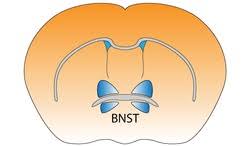(单词翻译:单击)
In the 1990s, researchers identified a tiny structure that played a key role in how rodents dealt with "ambiguous threats"—ones that didn't place them in immediate danger. Called the Bed Nucleus of the Stria Terminalis (BNST), it was about the size of a sunflower seed and located near the amygdala. While the amygdala appears to be the brain area primarily involved in activating the fight-or-flight response, the BNST kicks in when we have reason to remain hypervigilant—that hormone-driven state of hyperarousal we feel in our bodies when we are tense in the face of uncertainty.
在20世纪90年代,研究人员发现了一种微小的结构,这种结构在啮齿动物如何应对“模糊威胁”方面发挥了关键作用。它被称为终纹床核,大小与葵花籽相仿,位于杏仁核附近。虽然杏仁核似乎是大脑中主要参与激活“战或逃”反应的区域,但当我们有理由保持高度警惕时,终纹床核就会发挥作用——当我们面对不确定性时感到紧张时,我们的身体会感受到激素驱动的高度兴奋状态。
"What the amygdala is to fear, the BNST is to anxiety,"
“杏仁核对恐惧的作用,类似于终纹床核对于焦虑的作用,”

In a neuroimaging lab at the University of Louisville, Brendan E. Depue, a psychology professor, has shown how these findings in rodents manifest in humans. Placing students one by one in an fMRI machine, Depue simulated fear conditions by showing subjects images of fearful faces and playing them sounds of human screams. To simulate ambiguous threats, he simply projected a blank screen and informed subjects that a scream or fearful face could occur at any time, but the subject might also at any time be shown a neutral face and hear indistinct coffee shop chatter instead. Under these conditions, the amygdala consistently activated when the screams and scared faces appeared and the BNST was more engaged with the ambiguous threats.
在路易斯维尔大学的一个神经成像实验室里,心理学教授布兰登·E.赛义德展示了这些在啮齿动物身上的结论是如何在人类身上体现出来的。在功能磁共振成像仪中,研究人员让学生们一个接一个地观看,通过向他们展示恐惧面孔的图像,并播放人类尖叫的声音,来模拟恐惧状况。为了模拟模糊的威胁,他简单地投射出一个空白屏幕,并告知实验对象在任何时候都可能出现尖叫或恐惧的表情,但受试者也可能在任何时候看到一张中性的脸,而听到模糊的咖啡店聊天声。在这些条件下,当尖叫和恐惧的面孔出现时,杏仁核持续激活,而终纹床核则更专注于模糊的威胁。
"Mostly people who complain, or go into counseling, or seek therapy are really not there for a reaction to a fear stimulus," Depue says. "They're there because they're tormented by anticipation of an unpredictable event. It's just in their mind. It causes them to develop a chronic and maladaptive vigilance to the environment. We think that can be attributed more to the BNST than the amygdala."
“大多数人抱怨,或去咨询,或寻求治疗,并不是为了对恐惧刺激的反应,” 赛义德表示。“他们在那里是因为他们被不可预知事件的预期所折磨。这只是他们的想法。它使他们对环境产生慢性和不适应的警觉。我们认为终纹床核比杏仁核更能解释这一现象。”
译文由可可原创,仅供学习交流使用,未经许可请勿转载。


